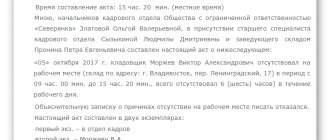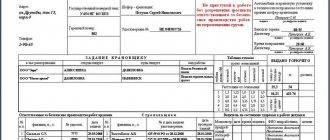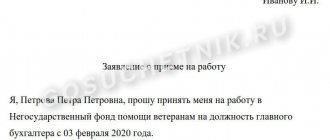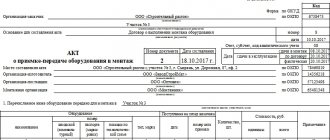The act of reconciliation with disagreements: how to draw it up correctly?
A reconciliation report that has disagreements is necessary to control all payments between business entities.
In some cases, such a document serves as a signal to an opponent who needs to take certain actions. These could be errors in accounting, incorrect posting of payments (statements) or the creation of a non-existent shipment. Information with discrepancies is the basis for re-verification of data and bringing accounting into compliance. Often, distortion of real figures leads to overdue debt to the creditor. For this reason, the act of reconciling differences allows for greater financial discipline.
Frequent cases when a reconciliation report with disagreements is drawn up:
- One of the reasons for the formation of a reconciliation report that has disagreements is often a wide range of products, which increases the likelihood of errors in accounting;
- When, according to the terms of the contract, the cost of services is floating. These are currency contracts or work with a product whose physical characteristics change monthly (for example, the cost of gas, which depends on calorie content).
There is no specific form of the act in the unified forms. Usually it is drawn up arbitrarily; organizations can fix its template in their unified forms, indicating it in the list of accounting policy forms. It is extremely important to take into account certain norms when drawing up, since on the basis of the act, disagreements between business entities will be resolved.
Regulatory regulation
The act form is usually downloaded on the Internet or used automatically in software. If such a form is not in the unified forms of the 1C program, it is modified by programmers to suit the needs of the enterprise.
This is quite simple to do, since a separate block is provided for the second party to the contractual relationship for manual confirmation of payments, shipments and fines. If the accounting department, which received such an act by mail, agrees with the data, the discrepancies are not reflected. If there are any, a mark is made at the bottom of the document, indicating your balance for the initial or final period for which the act was generated.
The video below will tell you how to draw up a form of discrepancy act:
Is a separate act needed?
Sample of discrepancies
To express disagreements, a free space in the footer of the document is usually used. In this case, the text part is also certified by the signature of the manager, chief accountant, and sealed.
How to sign
The organization that received the act and formalized the disagreement is obliged to approve its comments in writing. If the accounting department is confident in its abilities, then the discrepancies should be certified by the manager and stamped.
https://youtu.be/AGK_e50Z1cQ
Reconciliation of settlements with counterparties. settlement forms and examples of completion
An act of reconciliation of mutual settlements (mutual settlements) is an accounting document that is drawn up to reconcile mutual settlements between parties (organizations, individual entrepreneurs, etc.) for a certain period of time (month, quarter, year).
The data indicated in the act by the initiating organization must match the information of the counterparty. If discrepancies are found in the data, this is recorded in the final part of the document. Currently, the legislation does not establish an official form for such a document. Also, the obligation to draw up an act of reconciliation of mutual settlements is not established by law; however, this is one of the most common and sought-after documents in business transactions, necessary to comply with all terms of contracts.
The act of reconciliation of mutual settlements must indicate the number, reconciliation period, and name of the organizations. The act must contain a table in which the debit and credit data are entered on the numbers and dates of the primary documents confirming the delivery and payment of goods. The end of the form should contain the turnover for the period and the ending balance.
The act of reconciliation of mutual settlements is necessary:
- when the seller of the product provides a deferred payment
- when providing standard, regular services
- at high costs of goods and services
- when concluding a large number of contracts and additional agreements to them
The form of the act of reconciliation of mutual settlements is drawn up by the accounting department of the organization and signed by the general director and certified by the seal of the organization. The act is drawn up in two copies, which are subsequently sent to the counterparty. When sending the act, it is important to indicate the period during which the counterparty must sign the act and return one copy to the initiating organization. If representatives from organizations are sent to sign the reconciliation report, they must have powers of attorney with them.
Only chief accountants of companies can sign an act of reconciliation of mutual settlements, but this is only possible if no discrepancies are found in the act and the organizations do not have disagreements. It is worth understanding that in the event of a disagreement, an act submitted to the court without the director’s signature will not be valid.
When drawing up acts of reconciliation of mutual settlements, it is necessary to check several accounts:
- income calculations
- settlements on advances issued
- calculations for shortages
- settlements of accepted obligations
The act of reconciliation between organizations that do not have property disputes is purely a technical detail. Reconciliation can be carried out both for a specific contract and for the totality of commercial relations with the counterparty organization for a certain period.
Attention
For receivables and payables, including debts for which the statute of limitations has expired, reconciliation is carried out on the basis of contracts, invoices, invoices, invoices and other primary documentation. The document data is compared with the data reflected in the accounting accounts.
During cooperation, economic ties arise between any business entities. Mutual settlements between companies and enterprises, issuance and payment of loans, payment of taxes to government bodies - all these operations are related to money.
To avoid errors and discrepancies in the amounts paid by one party and received by the other, reconciliation statements are drawn up. The reconciliation report is a document that is not related to accounting and is not mandatory for preparation.
Info
It is formed at the request of one of the participants in the transaction and declares all amounts, payments and receipts that occur between organizations in a certain period of time. Dear readers! Our articles talk about typical ways to resolve legal issues, but each case is unique.
If you want to find out how to solve your specific problem, please contact the online consultant form on the right.
Many enterprises forget about such a document as the act of reconciliation of mutual settlements. This is explained very simply - not every accountant understands the importance of this document.
Important
The reconciliation report is important if you cooperate with your counterparty on an ongoing standard basis. Let us note that the act of reconciling calculations is not only a kind of demonstration of good manners.
The fact is that by signing the act of reconciliation of mutual settlements, the counterparty actually acknowledges the debt to you. Despite the fact that the courts declare that the reconciliation act has no legal force, without this document they will not even consider your lawsuit.
Contents of the article: 1. When is a Settlement Reconciliation Report necessary?2. How is the Settlements Reconciliation Report prepared?3. Who signs the Reconciliation Report for mutual settlements?4. How is mutual settlements reconciled?5. How to resolve controversial issues?6. Sample Reconciliation Report for mutual settlements7.
In this case, after a certain time, accounts payable are written off as expenses of the enterprise. How to resolve controversial issues? If your counterparty refuses to reconcile settlements, then perhaps he simply does not want to acknowledge his debt to your company.
We invite you to familiarize yourself with: Belonging to small and medium-sized businesses
Unfortunately, the initiator of the reconciliation cannot force the other party to sign the Reconciliation Report. To avoid such controversial situations, it is necessary to stipulate the following points in the contract:
- o the need to reconcile mutual settlements
- about the timing and frequency of such verification
- about the procedure for reconciliation
- on the timing of signing the Settlement Reconciliation Report
- on the collection of penalties for non-compliance with the terms of the contract
Thus, the act of reconciliation of mutual settlements is not only a formal document, it also has legal force.
Quite often, the results of such checks reveal debts: receivables or payables. If such facts are confirmed, you need to immediately make a reconciliation report and send it to the partner organization. Rules for drawing up an act There is no unified, standard form for drawing up an act, so it can be written in free form or according to a template developed at the enterprise.
A regular A4 sheet is suitable for filling. The act must be printed in two copies - one for each of the interested parties. Both signed and completed copies are sent to the counterparty, whose specialists compare the information from the sent report with the data they have.
If receivables are written off, they are included in the company's expenses, taking into account the debit of off-balance sheet account 007. The written-off amount is kept in the books for five years in case it is repaid by the debtor. Identified accounts payable are accompanied by corrections to the debit accounts. A creditor with an expired statute of limitations is included in the organization’s other income.
- reconciliation period;
- deadline for signing the act;
- sending option;
- a way to confirm disagreements.
A sample cover letter for a reconciliation report may look like this: “The organization is sending you, the organization, a reconciliation report on DD.MM.YYYY.
Is it possible to fill out a reconciliation report online and how to do it? The reconciliation report for mutual settlements is drawn up in two copies, which must be submitted... How a sample reconciliation report with the Pension Fund of the Russian Federation is formed in 2020 The responsibility of the policyholder is to pay contributions to the Pension Fund of the Russian Federation. It is necessary to periodically verify data with the fund to avoid arrears.
What does a sample reconciliation report with the Pension Fund look like in 2020 and on what basis is it created? The policyholder's confidence in the accuracy of settlements with the Pension Fund and the absence of arrears is ensured... Who signs the reconciliation act on both sides The article will reveal the main points regarding the reconciliation act. What is a document, what is its purpose, and who is obliged to draw it up - further.
The same check is carried out.
- In the case of a manual verification, all data from the table in the act is verified with the data of the primary documentation and the data available in the documents and reconciliations of the verifying party.
The reconciliation report is a standard protocol for agreements and differences in financial transactions carried out between two organizations. The document does not have a set form or specific requirements; it can be drawn up for use within a partner organization, between partners, or as indirect evidence when considering legal claims for debts. A correctly drawn up reconciliation report between counterparties will help control and regulate all financial relations that arise between them.
If you are interested in how to create a shift schedule, check out this material. Why is it necessary and how is an agreement for the provision of paid services with an individual concluded? Read here.
The role of the document in litigation It is important to remember that in the event of litigation regarding the fulfillment of the terms of a contract or the collection of a debt, a reconciliation act can be beneficial. But domestic judicial practice contains different attitudes towards its presence among the injured party:
- The signed act only reports the status of settlements, but does not confirm the fact that one of the participants in the process recognizes the debt.
We invite you to read: Interest-free loan for an apartment and a car
Attention
In this case, the company that is owed payment sends duplicates of the primary documents to the debtor organization. After they are carried out, a debt will appear in the accounting, which can be paid in the usual way.
Info
The law of the Russian Federation does not oblige the preparation of such a document. However, in business practice, reconciliation acts are found quite often and are secretly mandatory for registration.
- Carrying out periodic or ongoing reconciliations and recording their results on paper helps business partners avoid errors in calculations and payments, detect and repay debts in a timely manner, and eliminate other financial discrepancies.
- Moreover, if one of the parties owes the other and does not recognize the current situation, the reconciliation act can serve as one of the indirect evidence when filing a claim in court about the existence of a debt, and can also become one of the refutation factors.
When drawing up a paper, it must be certified by the signatures of the managers and chief accountants of both organizations, as well as wet seals.
How to compose correctly
When drawing up a reconciliation report, it is necessary to take into account the fulfillment of obligations under the contract, as well as the accuracy of the amounts appearing in the accounting records. To prepare the reconciliation, primary accounting documents are required, such as contracts, invoices, and delivery notes.
A correct reconciliation report must contain the following information:
The basis of the document is a table with calculated information. The left part reflects the data of the compiler’s organization, the right part – the data of the counterparty. Each party fills in the transaction number, its name, as well as the debit and credit for it. The last line indicates the turnover for the period and the ending balance as of the date of compilation.
If there are no disagreements regarding the preparation of the reconciliation report, and the final balance amounts in both parts of the table correspond to each other, the report is signed and transferred to the party that initiated the signing. If disputes arise, a protocol of disagreements is drawn up, indicating the controversial issues.
How is the ending balance determined?
Balance is nothing more than the difference between debit and credit. The balance is calculated for a certain period of time. There are opening balances, period balances and ending balances. The ending balance contains information about the difference between debit and credit at the end of the period.
The ending balance is defined as the sum of the account balance at the beginning of the period and turnover for a certain period. Universal formula for calculation:
Which sign will appear in front of the opening balance depends on its location in the table. If the opening balance is in debit, it must have a positive value, if in credit, it must have a negative value.
What is filled in the debit and credit columns
In the credit field of the table of the mutual settlements reconciliation report, information about payment for goods or services is filled in. Situations when the organization drawing up the reconciliation report has a debit balance with a positive amount mean that some of the work or goods remained unpaid. In cases where there is a credit balance, on the contrary, a debt to the buyer appears, that is, fewer services were provided than were paid for them.
Supporting documentation
When sending a statement of reconciliation of mutual settlements from one counterparty to another, a covering letter is often attached. The letter indicates a request to sign the reconciliation report and return it by mail to the specified address. In addition, a method for resolving disagreements is indicated.
As a rule, the cover letter has a similar content: “Company LLC sends Partner LLC a statement of reconciliation of mutual settlements as of December 20, 2016. We ask you to sign and email the scanned document no later than December 25, 2016. If there are disagreements, please draw up a protocol of disagreements.”
Protocol of disagreements
Any reconciliation act under the calculation table has a similar entry: “According to LLC “Company”, as of December 20, 2016, the debt in favor of LLC “Partner” is 100,000-00 rubles.”
If the counterparty of LLC "Company" agrees with this debt, he signs and returns the document to the sender. If, after filling out the table of the reconciliation report, Partner LLC has excellent entries, it must also reflect them under the table: “According to Partner LLC, as of December 20, 2016, the debt in favor of Company LLC is RUB 90,000-00.”
In order to focus attention on the differences in information for a particular operation, the disagreeing party can draw up a protocol of disagreements, indicating in it the point of the reconciliation report that is being called into question.
Covering letter for the reconciliation report
When sending a reconciliation report to the counterparty, a covering letter may also be attached to it. This letter indicates a request to sign the document and send it by reply letter to the specified address. In addition, the cover letter also specifies the manner in which the parties' differences may be resolved.
The wording in the cover letter could be as follows:
“Company LLC sends Firma LLC a statement of reconciliation of mutual settlements as of March 31, 2019. We ask you to sign the reconciliation report and send it as a scanned document by email no later than 04/05/2019. In case of disagreement, please draw up a protocol of disagreement.”
Sample reconciliation report with disagreements
Today there is no single unified form for the act of reconciliation with disagreements, so employees of enterprises can create it in any form or, if the organization has a developed and approved document template, based on its sample. It is only important that in its composition the document meets certain standards for the preparation of this type of documentation, and in its content it includes a number of certain information.
The following is written at the beginning of the document:
- its number, date of compilation;
- link to the reconciliation report on which disagreements are recorded.
- date of receipt of the previous reconciliation report;
- names of organizations between which the document was drawn up;
- if necessary, the number and date of the agreement under which the reconciliation is being carried out.
Then the main part includes:
It is more convenient to present information about specific points with which one of the parties expresses its disagreement in the form of a table. The number of the item in the reconciliation act, the subject of disagreement and your own version are entered into it. Then the conclusion is drawn up and the document is signed.
If any additional papers are attached to the act (copies of agreements, protocols, extracts, etc.), their presence must be reflected in the act itself as a separate paragraph.
Who is involved in drafting the document?
Any of the parties to the agreement may request a reconciliation report. It is compiled by an accountant using financial documents: bills, invoices, certificates of work performed, etc.
https://youtu.be/vdNwiXW11T8
Before sending the document to the counterparty, it is signed by the chief accountant, head of the organization or other authorized person. The reconciliation act will have legal force if it was signed by the head of the organization or the accountant has a power of attorney that allows him to sign all important documents of the organization.
Act of reconciliation with disagreements
You mention some EDI card. This means that you have in mind some system that has already been developed or is being developed for you. I cannot know the solutions built into your system. However, as far as our TerraLink xDE product is concerned, there are no such restrictions. Using our product, we can implement exactly the type of dispute protocol registration that is most preferable to you - in the same card, or in a separate card logically related to the first one, and/or optionally. Our TerraLink xDE product provides this flexibility entirely.
Thanks for the question!
We'll tell you how this is done in our Synerdocs service. There are two options.
The first option: you need to refuse to sign the reconciliation report and, if you refuse, indicate in the comments what exactly needs to be corrected. The counterparty will then have to issue a new reconciliation report and send it to you. This shipment will occur as part of the current exchange process, so it will be free of charge.
The second option: leave the act unsigned for now and simply create a new document - a protocol on disagreements, upload it, when sending, link it to the reconciliation act and send it to the counterparty. When the counterparty signs the protocol of disagreements (if his signature is required), sign the reconciliation report.
It's quite simple, right?
Good afternoon, guest We will supplement the answer of our colleagues
The act of reconciliation of mutual settlements is signed by the manager or representative acting on the basis of an issued power of attorney, which specifically states the authority to perform a particular action.
If the act of reconciliation of mutual settlements contains only the signature of the chief accountant, then such a document may be considered invalid if this person is not authorized by the manager to take such actions. In this case, the reconciliation act is considered as a technical document of an accounting nature, it is not a document of title giving rise to the rights and obligations of the parties, but only confirms the amount of debt as of a certain date and does not indicate the defendant’s recognition of the debt, therefore, does not interrupt the running of the limitation period (see , for example, resolution of the Federal Antimonopoly Service of the Far Eastern District dated February 16, 2009 N F03-250/2009).
Reconciliation of settlements between counterparties is not a transaction*(1). The letter of the Federal Tax Service of the Russian Federation dated December 6, 2010 N ШС-37-3/16955 states that the reconciliation act is not the primary accounting document confirming the completion of a business transaction, since the financial condition of the parties does not change.
Thus, the reconciliation act is not a primary document. Its preparation is not mandatory, but rather of an auxiliary nature in settlements between counterparties under contracts (see also the resolution of the Federal Antimonopoly Service of the Ural District dated November 10, 2009 N F09-8688/09-C3).
In case of disagreement between the parties, the act cannot serve as confirmation of the existence of a debt and, therefore, the signing of such an act has no consequences in the event of legal proceedings, assignment of claims, or during a tax audit. Disagreements should be reflected on the right side of the act, and a detailed explanation of the disagreements should be given either in the act itself or in the letter attached to it. To eliminate the possibility of discrepancies in the act with disagreements, you have the right not to sign it, but to draw up your own and send 2 copies to the counterparty. with a letter of disagreement regarding his reconciliation report attached.
Signing the reconciliation report indicates recognition of the debt!
To verify financial transactions that are carried out within the framework of contractual relationships, organizations use the reconciliation report form. The company's counterparty has the right to agree with the data provided by the other party or to express disagreement with the specified information. For confirmation of each operation, there is its own part of the section for the second organization.
A reconciliation statement with the differences indicated therein is usually prepared in response to a document issued for the purpose of making mutual settlements. The main reason for drawing up the act is the presence of discrepancies in information.
Why is a reconciliation report drawn up?
The preparation of this document begins at the initiative of one of the parties. In this organization, the accounting department is tasked with drawing up a special form in two copies. If he is absent, then an authorized person will do this. Before sending a package of documents to the counterparty, the act must be endorsed by the signature of the head and the accounting department, as well as a stamp, if available.
The purpose of the document is obvious - the actual recognition of the debt of one party to the other. We recommend drawing up a statement of reconciliation of mutual settlements:
- when cooperation between organizations (parties to the agreement) is long-term, permanent
- before concluding additional agreements and other contracts
- when providing deferred (installment) payment
- for insurance in case of filing a claim in court.
Is the act of reconciliation of mutual settlements evidence in a civil case? Of course, the court evaluates evidence based on its internal conviction. The act signed by both parties also indicates the existence of legal relations between the parties, the existence of debt and even its size. At the same time, a reconciliation act without the signature of an authorized person is controversial evidence.
The act of reconciliation of mutual settlements is drawn up by accountants using the 1-C program. However, individual entrepreneurs often take on the responsibilities of an accountant themselves. The document must include the following information:
- names of the parties;
- basis for the debt (details of the agreement);
- details of primary documents;
- the actual inflow and outflow of funds between counterparties;
- signatures of authorized persons. The document must have the director's signature.
We invite you to familiarize yourself with a sample driver job description
If the counterparty does not want to sign a reconciliation report, therefore, it does not intend to recognize the debt, which may indicate the need to send a claim to the buyer under the supply agreement and file a claim in court to recover funds.
What is an act of reconciliation with disagreements?
Its purpose
The preparation and verification of the data reflected in such a document should be treated with extreme care. Often, the drafter of the act does not set himself the goal of bringing the data into compliance, but of appealing to the courts. People usually do not rush to sign such papers, but try to contact the accounting department of the organization that initiated the creation.
As noted above, there is no formal form for the reconciliation act. However, it is precisely this form that accountants most often prefer to use to support accounting information. Therefore, for design, it is not its form that is more important, but the correctness of filling. The form is processed according to the rules specified in the current version of the Accounting Law.
Sample of filling out a reconciliation report for mutual settlements
Once the debt is generated, it can be paid. In this case, you can pay the debt according to the reconciliation report, indicating it as the basis in the payment order. If you find an error in your accounting, you need to correct it. In this case, an article about correcting accounting errors will help you.
8. How to make a reconciliation with counterparties in 1C version 8.3. How to make a reconciliation with counterparties using the 1C: Accounting 8 edition 3.0 program, see the video.
Important
We invite you to familiarize yourself with: Sample agreement for exchange of shares in apartments
According to the law, an act of reconciliation of mutual settlements may be grounds for interrupting the three-year limitation period. That is, in cases where the debtor signs a reconciliation report within three years, he is considered to have recognized his debt obligations and is obliged to repay them within the established time frame.
Instructions for filling out the reconciliation report In the “header” you need to enter information about the period for which the reconciliation report is being carried out, and also indicate the agreement that served as the basis for the creation of this document. Here you should enter the name of the companies in accordance with the constituent documents (it is possible without such details as KPP, INN, OGRN, etc.).
- the name of the document, as well as the date of its preparation;
- the name of the originator’s organization and the name of the counterparty with whom the act is signed;
- indication of officials authorized to sign acts of verification of their surnames and initials, as well as signatures.
The reconciliation act itself is usually drawn up in the form of a register of documents, ordered by the date of their creation. Sometimes, instead of documents, the essence of the transaction is indicated (sale, purchase, payment, etc.). In order for the reconciliation act to be up-to-date, it is better to draw it up from the beginning of cooperation or from the moment of signing the last reconciliation act.
- documents did not reach the counterparty
- within the company, the documents were not transferred to the accountant for inclusion in accounting
- postings according to documents in the first company were made in one period, and in the second - a period earlier or later
Moreover, there may be no documents:
- in your company's accounting
- in counterparty accounting
When checking the settlement reconciliation report, which was provided by the counterparty, it is immediately clear in which documents there are disagreements. 5. What should an accountant do if the documents are not in the records of his organization? Situation 1: the company is a buyer of material assets. Step one.
It is necessary to check whether these documents were posted in another period, for example, following the reconciliation period. If you do not have documents regarding which there are disagreements in the accounting reconciliation report, then proceed to step 2.
Step two. If necessary, the act can be certified with a seal, but since 2016, the presence of a seal for legal entities is not a legal requirement (however, without a seal, in the event of litigation, the document may be considered invalid). To ensure that the process of signing the reconciliation report does not drag on, when sending the document you should indicate the time frame within which it must be returned.
Purpose of drawing up the act If the information in the document drawn up by the initiator of the reconciliation does not coincide with that of his counterparty, then at the end of the document the existing discrepancies should be recorded. The same applies to debts: if such facts are revealed, it is necessary to indicate the period during which they should be repaid. Otherwise, the court, if a claim arises, will not be able to take into account the argument regarding the violation of the terms of money transfers.
How to file discrepancies in the AS
https://youtu.be/SHA6ZSVpK5w
As a rule, a special act specifically with discrepancies is not formed, because the differences in accounting are not yet known. The accounting department of the enterprise, having received two copies of the document, processes them in a similar way.
If some data does not suit her, appropriate notes are made. Based on the discrepancies, the second party accepts objections, but this does not mean that the document with comments will be signed.
In the practice of Russian organizations, such an appendix to the reconciliation report is rarely used. It is more correct to apply such a document to agreements or contracts.
A sample protocol can be downloaded here.
How to Reflect Discrepancies
By default, the form contains a tabular section. The left one is filled in by the creator, and the second part remains blank - for the counterparty. If there are few positions, the accountant of the meeting company can enter data opposite each number.
If there are a lot of payments and shipments, reconciliation for discrepancies begins with checking the incoming and outgoing balances. The discrepancy between the accounting data is reflected either line by line or is included in the main (substantive) part of the act.
The video below shows how to compare speakers in a special program:
Decor
Despite the fact that the legislation does not establish clear requirements for the form of drawing up a document, basic principles for performing an operation have developed in office work. They need to be taken into account. The reconciliation report is the primary document.
For this reason, it must contain:
- Name.
- Date of preparation.
- Full name of the organization that compiled the paper.
- Full name of the partner company.
- Full name of officials who have the right to leave a signature on the document.
- Signatures.
The act is drawn up in the form of a register. The specialist performing this task must be guided by the legal requirements for primary documentation.
It must include all operations that were performed during the reporting period. Typically, reconciliation needs to be carried out once a month.
The papers included in it must be organized. Usually the action is performed by date. Additional papers are not always included in the act. Sometimes instead of them there is an indication of the essence of the operation.
The compilation procedure should not be completed at once. The act must be completed from the moment the cooperation with the partner begins or after the previous document is closed.
For a document to have the force of a normative legal act, the signature of the originator is not enough. The paper must contain the seals of organizations participating in the process. In addition, the document must bear the signature of a senior official of the company.
Who owes whom
To understand which party remains the debtor, you just need to carefully study the act of mutual settlements.
For example, you are a supplier of a product. But you have not shipped it yet, even after receiving the funds. Thus, you are the debtor. In this case, you, as the supplier, undertake to ship the specified goods. By sending a shipping invoice to your counterparty, you close your debt. Usually the act is drawn up for a certain period. It allows you to calculate the amount of debts on credit and debit. Using simple calculations, the remainder is revealed. If it is debit, then you owe it, if it is credit, you owe it. Essentially, there is nothing complicated here. The main thing is to carefully study the document and carefully make calculations.
Storage period for the reconciliation report
The law imposes mandatory retention periods primarily on primary documents. The act of reconciliation of mutual settlements is not one of these. Its compilation is explained by business transactions, which is not regulated by law. Thus, how long this act should be kept is determined by the accounting policy of the organization. In other words, each company itself determines how long to store such documents.
( Video : “How to reconcile settlements with counterparties”)
Filling rules
The paper is compiled in free form by the enterprise's accounting department. For the documentation to come into force, it must be signed by the chief accountant and director of the enterprise. After completing the action, the document is certified with a seal. Both copies of the paper are handed over to the partner with whom the act is drawn up.
The company specialist must carefully study the submitted document. If he agrees with its contents, the paper must be certified by the seal of the 2nd party and signed. 1 copy is returned to the party involved in the drafting, and 2 remains with the partner.
There must be a serial number on the paper. The frequency of compilation is determined by the organization initiating the process. The information present on the paper must be verified with the invoice information.
The information that the institution provides for inclusion in the documentation must match the information of its partner. If there are discrepancies, the moment must be recorded at the end of the document.
Signing of the paper is carried out only if there are no disagreements between the interacting enterprises. The presence of conflicts may become a reason to go to court. However, a document not signed by the manager cannot be taken into account as evidence.
Reconciliation report: fill out online
In MyWarehouse, you can fill out and download a reconciliation report in Excel - for each counterparty you will immediately see receipts, expenses and balances. You no longer need to look for debt on your own - the service will do it for you. Just enter or select a previously entered counterparty and indicate the desired period, and the system will generate a document. Below is a reconciliation report: an example of filling out the form in MySklad.
The document will contain mutual settlements at the beginning of the period, a list of payments and the final debt. All information about counterparties and settlements is stored in MyWarehouse. Fill out the reconciliation report online - and you won’t have to enter the data again each time.
Who signs the reconciliation report?
The act can only be signed by the director. The document is stamped. The chief accountant signs if there is a power of attorney.
Both signed copies are handed over to the counterparty. If he agrees with the data, he puts a stamp and signature and returns one document to the initiator.
If the counterparty does not agree, a reconciliation report with disagreements is drawn up. See below for a sample filling.
Carrying out the reconciliation procedure
The reconciliation action is carried out only for one item. In order for the information present in the act to be objective, the documentation should be drawn up after receipt of the goods or from the moment the previous act was closed. The reconciliation process can be combined with performing an annual inventory. This will protect company specialists from doing double work. The operation will reveal the presence of debt.
If discrepancies are identified during the inventory process, a reconciliation report should be immediately drawn up and sent to the counterparty.
Documentation can be submitted by mail. However, if a specialist is afraid of losing paper during delivery, it is better to deliver it personally. This will speed up the process and prevent you from having to fill out the form again. The counterparty who received the documentation must verify the information. If no discrepancies are found, the form must be signed and sealed. One copy of the document remains with the partner organization, and the other must be returned to the sender.
If a debt has been identified on the part of a partner, a notification must be sent along with the document with a request to repay it.
In practice, it is not uncommon for the purchasing organization to go bankrupt over the past period of time. Then it will not be possible to collect the identified debt. The amount of identified accounts payable will have to be written off for the current needs of the enterprise.
How to print a reconciliation report in 1c
There are many programs that allow you to fill out a reconciliation report. The most common are 1C software systems. Before printing the reconciliation report in this program, it must be filled out. The filling algorithm is standard for any standard 1C configuration, both for 1C.Accounting and 1C.Retail.
- When you click the “Create” button, a new document form is displayed in which you need to fill in the basic details.
- After filling in the fields with information, you should proceed directly to filling out the data on mutual settlements.
- Once the document is completed, it is recorded using the "Record" button. In this form, the generated document is sent for printing.
- After the reconciliation act has been agreed upon and signed by the counterparty, you should set the “Reconciliation approved” flag, which will prohibit editing the document.
The reconciliation act allows you to take an inventory of payments, check with the data of business partners, and verify the presence of receivables and payables.
Download document templates in Word and Excel formats.











